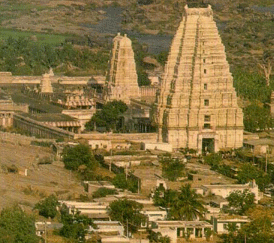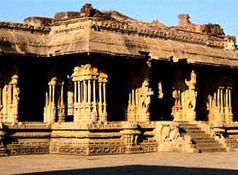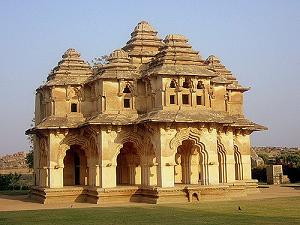|
|
|
Hampi |
|
Information about Hampi |
|
Hampi, once a flourishing capital of the Vijayanagar Empire, is a very small village in the Northern Karnataka. Hampi exhibits the vast relics of the city of Vijaynagar, also known as the City of Victory. The Vijaynagar empire extended from the Arabian Sea to the Bay of Bengal and from the Deccan Plateau to the tip of the peninsula. It was built as a showpiece of imperial magnificence. The main attraction in Hampi are the temples built by the Vijaynagar empire. The temperature in Hampi ranges from 23 to 38 degree Celsius in summers and 10 to 15 degree Celsius in winters. Hampi can be visited throughout the year, except from April to June, when it is very hot.
|
|
|
|
History
of Hampi |
|
Hampi was the seat of the Vijaynagar empire. The Vijaynagar rulers were the great lovers of art and architecture which can be known from the carved temples, monuments and sculptures in Hampi and all over the South. The Vijayanagar rulers patronised a variety of Hindu cults and also permitted the practice of other religions. Under their enlightened leadership, the city became rich and a cosmopolitan blend of people with a wide variety of linguistic, ethnic and religious background. The Krishnadeva Raya, who raised his empire to the Zenith of its glory during 1509-1529 was the most outstanding ruler. But in 1565, the combined armies of the Muslim Sultanates defeated the Vijayanagar ruler and plundered, burnt and sacked the abandoned city mercilessly, and left some ruins for the treasure seekers. Today, the temples and palaces are scattered over an area of 25 square km. The rulers also introduced new techniques in warfare, buildings, waterworks and agriculture. Today, some of the irrigation networks constructed by them are still in operation.
|
|
|
|
Tourist Attractions in Hampi |
|
The main
tourist attractions in Hampi are its temples.
The various temples in Hampi are Virupaksha Temple,
Vittala Temple. The other tourist attractions in Hampi
are
Lotus Mahal,
Hazara Rama Temple, Queen's Bath and Tungabhadra Dam.
|
|
Virupaksha Temple
Virupaksha Temple is one of the few temples amidst the ruins, that is still worshipped. At the heart of the
complex are several minor shrines that belongs to the Chalukya and Hoysala periods, completely
engulfed by Vijayanagar extensions. The eastern gateway which is 50 metres high, is a marvel of
engineering skill. The hall leading to the sanctum sanctorum has finely carved columns of animals. The
ceiling is painted with scenes from mythology. To the south of the
Virupaksha Temple are the two colossal monolith images of Ganesha carved on boulders. One of the image of Lord Ganesha is enclosed
in a temple with unusually tall columns and other stands within an open hall. Further south, the statue of Narasimha is situated which is carved out of a single boulder. |
 |
|
|
|
 |
Vittala Temple
Vittala Temple, despite its ruined state, represents the highest achievement of Vijayanagar art. The
temple stands on a rectangular courtyard. Its 56 columns
are richly carved with fantastic beings and rampant animals. The elaborately and delicately chiseled brackets, support the columns and the ceiling. The
slender columns echo with music when tapped. Ceilings are decorated with foliage and geometric designs. The elongated columns of this structure are sculptured with animals and figures and are
intricately ornamented. |
|
|
|
|
Lotus Mahal
Lotus Mahal is a two-storeyed pavilion on a stepped plan. This palace was inspired by the beauty of a woman. Hindu and Islamic architectural elements are
skillfully blended that displays the Vijayanagar courtly style. Today, the tower is in a dilapidated state, and guarded by eunuchs.
Hazara Rama Temple
Hazara Rama Temple is the family temple of the rulers
and surrounded by enclosures containing
buildings and ruins associated with the king,
court and military. Finely carved basalt pillars
depict the incarnations of Vishnu. The exterior
walls are sculptured with events from the
Ramayana. |
 |
|
|
|
|
Queen's Bath
The Queen’s Bath, a water pavilion exposed to the sky, was built in an Islamic style. It consists of a square water basin surrounded by a vaulted corridor. A
lotus-headed fountain once sprouted perfumed water into the pool. The overhanging filigreed balconies were for the ladies of the court to watch the fun and frolic in the bath.
Vitthala
Temple
This magnificent temple complex is undoubtedly
the best example of Vijayanagar art and architecture. Its construction was
started in 1513, by Krishnadevaraya, but was not completed even after the
shifting of the capital to Penukonda in 1565. the grandur of the shrine is
reflected in a legend, which says that Lord Vishnu found it too grand to live
in and returned to his own ‘humble home’. The impressive Kalyana Mantapa and
the exquisitely carved stone chariot in the courtyard are the main attractions.
The technical conceptions is so ingenious that the stone wheels of the chariot
actually rotate. Equally impressive are the 56 musical pillars in the large
Ranga Mantapa, that emit musical notes when tapped.
Lord Virupaksha
Temple
The temple complex is dedicated to Virupaksha,
an aspect of Lord Shiva and the guardian deity of the Vijaynagar kings. It lies
at the western end of a 700 metre long street, which was once the famous Hampi
Bazaar. The exquisitely carved 50 m. high gateway at the entrance is believed
to be from earlier period and was renovated in 1510, by Krishnadeva Raya.
Within the temple courtyard are many small shrines and pillared halls. The
ornately carved hall outside the central shrine has paintings on its ceiling
depicting mythological scenes. Other worth visiting temples are – Sasuvekalu Ganapathi and
Krishna Temple Complex.
Ugra Narasimha
This 6.7 metres high splendid sculpture of Ugra
Narasimha is seated under a canopy of seven hooded snake, carved out of a
single stone. To the left of the statue is a huge linga (Badavi Linga) set
under running water.
Mahanavami Dibba
or the ‘House of Victory
It was built by Krishnadevaraya after his
victorious expedition to Orissa. The spaces between the rows of the plinth –
mouldings are ornately carved. The royalty witnessed colourful celebrations of
the nine day Dassara festival from here.
Tungabhadra
Dam
Tungabhadra Dam is the South India’s largest stone masonry dam built across the Tungabhadra river. The reservoir has a storage capacity of 132,559 million
cubic feet of water. It contributes 99000 KW of electric power.
Elephant Stables
The elephants of the royalty were kept in this
imposing edifice with arched entrances and many domes |
|
|
|
|
|
Festivals in Hampi |
|
The Hampi festival is held every year in the first week of November. Music and dance programmes, drama, fireworks, puppet shows and spectacular
processions are a part of this festival. This festival is organized by the Karnataka state government in order to recreate the grandeur of the ancient
Vijayanagar empire. The artists from every part of India gather here to take part and enjoy the festival.
|
|
| |
|
Around Hampi |
|
Anegundi
The site across river Tungabhadra is associated with epic
Ramayana and is said to be located in the mythical kingdom
of Kishkinda. The Anjanadri Hill, near Anegundi is said to be the birthplace of the Lord Hanuman. Around Anegundi
are a number of ancient temples and fortifications. The main attractions are – Huchappayana Mata Temple.
Sacred Pampa Sarovara,, Aramane (a ruined Palace) and the Ranganatha Temple.
Hospet (12 kms.)
This gateway to Hampi lies 61 kms. From Bellery. It was
founded by Krishnadevaraya. The main attraction is the picturesque temple
of Jambhunatha set on a hill nearby.
|
|
|
|
|
How
to reach Hampi |
|
By Air:
The nearest airport is located at Bellary, about 77 kms. Bellary is connected by various infrequent flights.
By Rail:
Badami is on the Bubli-Sholapur metre gauge line and is connected to Bangalore, Bijapur and Bagalkot.
By Road:
Hampi is connected with all parts of Karnataka and to Hyderabad by road. Some of the nearby cities are Pattadakal, Aihole, Badami, Bijapur and
Bangalore.
|
|
|